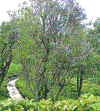| Plus |
|
||||||
|
Thriving wildlife of Galle and Rumassala When Anoma Algiywady and I examined a flock of terns at the bridge within sight of the Lighthouse Hotel, we came across a flock of 300-400 Little Terns, roosting on the beach. Less than half-a-dozen Gull-billed Terns in breeding plumage and a similar number of White-winged Black Terns in non-breeding plumage were also present. Only about 5% of the Little Terns had the yellow bill acquired in breeding plumage.
Before lunch, Anoma and I visited the home of Sameera Akmeemana, who had done the layout of the dragonfly poster of the Wildlife Conservation Society of Galle. His house is a few hundred metres inland from the Galle Fort at the base of a scrub and tree covered hill. It's an amazing reservoir of wildlife. There was an endemic Whistling Lizard (Calotes liocephalus) holding territory on a mango tree. This may be one of the first records from such an urban environment. It characteristically stayed about ten feet above the ground. A troop of Purple-faced Leaf Monkeys, endemic mammals, perched on the trees in the neighbouring gardens. A family of Brown Mongooses bickered, where apparently a mother had two cubs and one had dashed across. About two years ago, Sameera had even had a Fishing Cat crossing his garden. A pair of Spotted Doves flew in and were not concerned at me crouching down and photographing them. Around 4.30 p.m. we visited Rumassala, which still has perhaps a few hundred acres of degraded forest and secondary forest and scrub. The jungle beach was good for butterflies. Several Plum Judy's were present on grassland near the beach. We had a view of one of the two largest Lycaenid species near the temple. They flew out showing relatively large blue wings and then dove into a shaded thicket, which was about 10 feet above the ground. The height at which it roosts may be one of the reasons why it is so hard to see. Common Sailors and Common Pierrots were present in good numbers. Although Common Sailors are a common butterfly, this was the first time I made a conscientious effort to photograph the under-side. In preparing the first edition of the Butterflies of Sri Lanka and Southern India booklet, I realized that I did not have a photograph of the under-wing. A Nigger was active when dusk was settling in. We also saw what may have been a Long-winged Skimmer (Lathrecistica asiatica), but could not be sure as it flew away. On the beach we watched hermit crabs labouring along the sand, dragging the shell of a long dead marine snail.
Gehan's Journal is an ad hoc series of lightly-edited extracts from the 'on the hoof' notes maintained on his laptop by writerand photographer Gehan de Silva Wijeyeratne
Jacaranda – a graceful beauty This beautiful tree grows to a medium height of about 50 feet. The leaves are large and bipinnate. They are divided into tiny segments and have the fine appearance of a fern. Each leaflet is oblong with a pointed end and is slightly larger than the previous one, while the terminal leaflet is larger than the others. The delicacy of its leaves make the Jacaranda appropriate for growing as an ornamental foliage plant in pots as suggested by Macmillan. The flowers of the Jacaranda are large and mauve-blue. They appear in clusters and each flower is bell-shaped with a tube. Some of the lobes are smudged with a spot of white. During the flowering season, from March to May, the entire tree is covered in these clusters of flowers.
The fruits of the Jacaranda are flat capsules, filled with many seeds. The trunk of the tree is light-coloured, and the tree usually grows straight and tall. The Jacaranda was introduced to Sri Lanka in 1886 from Brazil and grows well in dry and moist climates. It has been planted throughout the hill country and blazes of blue can be seen at this time of the year. Look out for it as you drive through Haputale and Bandarawela and in Colombo in the grounds of the Cathedral of Christ, The Living Saviour, next to the BMICH. In South America, the tree has medicinal uses, but it is not known whether these uses have been discovered by Sri Lankan ayurvedic specialists. The local names for this tree are unknown. The scientific name is Jacaranda mimosaefolia or Jacaranda acutefolia which refers to its acute leaves. Compiled by Ruk Rakaganno |
|||||||
Copyright © 2006 Wijeya Newspapers
Ltd. All rights reserved. |
-Gehan-de-S.gif)

